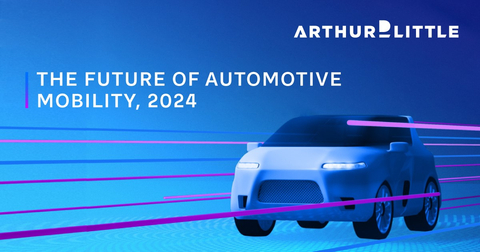LONDON--(BUSINESS WIRE)--Arthur D. Little today released the 2024 edition of its Future of Automotive Mobility study, highlighting the key trends and challenges facing the global automotive market. Based on primary research with over 16,000 consumers in 25 countries, it demonstrates that predictions from the last decade of a world of connected, autonomous, shared and electric (CASE) mobility are far from becoming a reality.
While vehicles are increasingly connected, consumers want their driving to be assisted, rather than completely autonomous, due to safety concerns, and are still committed to taking individual, not shared journeys, with overall car ownership growing. Progress on electric mobility is accelerating, but with a greater emphasis on hybrid options, rather than a direct switch to battery electric vehicles (BEVs). However, 44% of current internal combustion engine (ICE) drivers globally still plan for their next vehicle to be ICE-powered, a figure that rises to nearly two-thirds (65%) in the US.
The study, first published in 2015, highlights a growing gap between mature automotive markets (NE Asia, North America, and Europe) which are close to peak motorization but with consumers who are less open to new innovations in digitalization and autonomy, and the growing markets of China, India, SE Asia and the Middle East. Here, car ownership is increasing in importance, with consumers very open to product and channel innovation. Electrification cuts across these two groups - mature markets, apart from the US, are rapidly embracing EVs, yet, with the exception of China (the global leader), growing markets are slower to adopt them.
Richard Parkin, Partner, Automotive and Growth Practices at ADL, comments: “Our research shows that the simple view of unidirectional progress toward a connected, autonomous, shared, and electric (CASE) world is increasingly untenable, as both producers and consumers reassess costs and benefits. We are also seeing significant and increasing divergence between the mature markets of the US, Europe, and North Asia, which are at peak motorization, and the more dynamic, yet price-sensitive, markets of the rest of Asia and the Middle East. To be successful automotive OEMs must meet a range of challenges - convincing drivers to switch to EVs, navigating regulatory and geopolitical challenges, and addressing the impact of new disruptors, such as Chinese EV makers, all while increasing digitalization.”
The study focuses on five topics – car ownership profiles, the adoption of new mobility services, autonomous driving, alternative drivetrains (including EVs), and the impact of digital tools on sales models. Findings include:
- De-motorization is a limited, urban phenomenon – for example, 76% of those in European cities with a population of over 5 million (all of which have strong public transport networks) are prepared to give up their car, but generally car ownership is growing globally.
- Less than 50% of consumers have tried new mobility services such as ride and car sharing. Ride hailing, which is simply a taxi with a digital user interface, is popular in all regions.
- Nearly two-thirds (65%) of consumers cited safety risks due to machine error as their biggest concern around autonomous driving, with trust levels not increasing significantly over the last five years.
- Hybrid and plug-in hybrid powertrains will play a significant role in future mobility, with 34% of global consumers expecting their next vehicle to be a form of hybrid, the same number as ICE, and ahead of pure BEVs (26%).
- The physical (often dealer) channel remains relevant, with over three-quarters (77%) of global consumers citing personal consultation during the automotive purchase process as the number one factor driving satisfaction, limiting opportunities for full digitalization, although 53% of those in the Middle East are open to closing the deal online.
The 2024 Future of Automotive Mobility study can be downloaded here: https://tinyurl.com/ymxrunny
For further information, please visit www.adlittle.com




